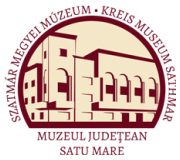Szőcs Péter Levente (szerk.): Călătorii istorice pe Valea Someşului. Ghid turistic (Satu Mare, 2014)
Valea Vinului
er with the Orthodox church dedicated to St. John the Baptist, built in 1856. Măriuş was mentioned in 1424 for the first time as part of the Medieşu Aurit domain. It was owned later by the Károlyis. The Orthodox church of Archangels St. Michael and Gabriel was built in 1881. An Orthodox monastery dedicated to The Spring of Healing was founded close to Măriuş in 1993, and since then it became a major pilgrimage site. Close to the monastery, an open-air museum dedicated to the traditional village of Satu Mare was created, in 2012. It contains at this moment so far, only a single traditional house, built in 1864, characteristic for the Codru region, and moved here from Pomi. The interior was organized in accordance to the local traditions. Roşiori was mentioned in 1409 for the first time. It was part of the Seini domain during the Middle Ages, and later it was shared by several nobles. The Orthodox church of Epiphany was built in 1871. Sâi was mentioned in 1424 for the first time, it belonged to the Ardud domain during the Middle Ages, and it was owned by the Károlyis after the Peace Treaty of Satu Mare in 1711. Its new owners settled a Schwabian population in 1760, part of them left in the Second World War joining the German army. The Roman Catholic church, testimony of the village’s German speaking community, was built in 1879 and it was dedicated to St Ana. The Orthodox church of the Assumption of the Holy Virgin dates from 1984. Măriuş • Mogyorós Casă tradiţională din muzeul în aer liber Hagyományos ház a szabadtéri múzeumból Traditional house in the open air museum Măriuş, mănăstirea ortodoxă Mogyorós, ortodox kolostor Măriuş, Orthodox monastery Vedere aeriană • Légifelvétel • Aerial view 73
